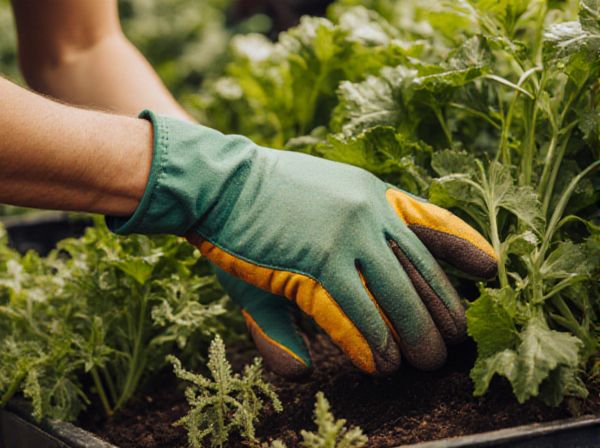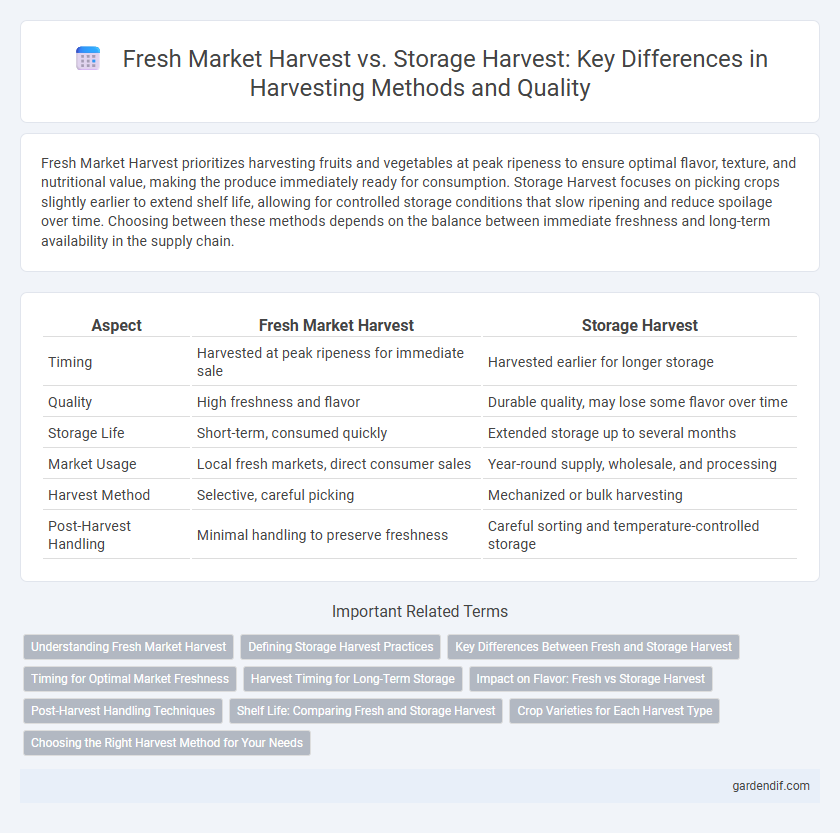
Fresh Market Harvest vs Storage Harvest Illustration
Fresh Market Harvest prioritizes harvesting fruits and vegetables at peak ripeness to ensure optimal flavor, texture, and nutritional value, making the produce immediately ready for consumption. Storage Harvest focuses on picking crops slightly earlier to extend shelf life, allowing for controlled storage conditions that slow ripening and reduce spoilage over time. Choosing between these methods depends on the balance between immediate freshness and long-term availability in the supply chain.
Table of Comparison
| Aspect | Fresh Market Harvest | Storage Harvest |
|---|---|---|
| Timing | Harvested at peak ripeness for immediate sale | Harvested earlier for longer storage |
| Quality | High freshness and flavor | Durable quality, may lose some flavor over time |
| Storage Life | Short-term, consumed quickly | Extended storage up to several months |
| Market Usage | Local fresh markets, direct consumer sales | Year-round supply, wholesale, and processing |
| Harvest Method | Selective, careful picking | Mechanized or bulk harvesting |
| Post-Harvest Handling | Minimal handling to preserve freshness | Careful sorting and temperature-controlled storage |
Understanding Fresh Market Harvest
Fresh Market Harvest prioritizes picking fruits and vegetables at peak ripeness to maximize flavor, texture, and nutritional value, ensuring superior quality for immediate consumption. This method demands careful timing and fast distribution to maintain freshness, contrasting with Storage Harvest, which focuses on durability and extended shelf life through early picking and controlled atmosphere storage. Understanding these differences helps optimize supply chains and meet specific market demands for fresh, flavorful produce.
Defining Storage Harvest Practices
Storage harvest practices involve collecting crops at peak maturity and conditions ideal for extended preservation, ensuring minimal moisture and mechanical damage to reduce spoilage. Fresh market harvest emphasizes immediate consumption quality, focusing on optimal ripeness and appearance to meet consumer preferences. Proper storage harvest techniques include controlled temperature and humidity management to maintain crop freshness during long-term storage and transportation.
Key Differences Between Fresh and Storage Harvest
Fresh market harvest involves picking fruits and vegetables at peak ripeness to ensure maximum flavor, texture, and nutritional value, whereas storage harvest fruits are picked earlier to prolong shelf life and reduce spoilage. Fresh harvest crops require more delicate handling and quick distribution to maintain quality, while storage harvest commodities undergo controlled atmosphere storage with regulated temperature and humidity to extend freshness. Key differences include timing of harvest, post-harvest handling methods, and intended market goals--immediate consumption for fresh market versus long-term availability for storage harvest.
Timing for Optimal Market Freshness
Fresh market harvest is precisely timed to capture peak flavor and nutritional value, ensuring produce reaches consumers at its freshest. Storage harvest occurs slightly earlier to allow for curing and controlled atmosphere storage, extending shelf life but slightly reducing immediate freshness. Optimal market freshness depends on balancing harvest timing with post-harvest handling and storage technology.
Harvest Timing for Long-Term Storage
Harvest timing plays a crucial role in differentiating fresh market harvest from storage harvest. Fresh market harvest prioritizes picking crops at peak ripeness to maximize flavor and texture, whereas storage harvest targets optimal maturity that balances flavor retention and extended shelf life. Timing the storage harvest involves careful monitoring of crop maturity indices to ensure minimal post-harvest spoilage and preserve nutritional quality during long-term storage.
Impact on Flavor: Fresh vs Storage Harvest
Fresh market harvest delivers peak flavor intensity by capturing fruits and vegetables at their prime ripeness, preserving natural sugars and aromatic compounds. Storage harvest, often picked earlier and stored under controlled conditions, can lead to a slight decline in flavor complexity due to delayed ripening and moisture loss. Consumers typically prefer fresh market produce for its vibrant taste and enhanced sensory experience compared to storage harvest counterparts.
Post-Harvest Handling Techniques
Fresh market harvest requires delicate post-harvest handling techniques such as immediate cooling, gentle washing, and careful packaging to maintain maximum freshness and extend shelf life. In contrast, storage harvest involves rigorous processes including curing, controlled atmosphere storage, and moisture regulation to minimize spoilage and preserve quality over extended periods. Efficiently managing temperature, humidity, and sanitation in both methods is critical to optimize produce quality and reduce post-harvest losses.
Shelf Life: Comparing Fresh and Storage Harvest
Fresh Market Harvest offers superior shelf life due to immediate consumption and minimal handling, preserving nutrient quality and freshness for up to 7 days. In contrast, Storage Harvest extends availability for several months through controlled atmosphere conditions, but this process can slightly reduce nutrient levels and alter texture. Optimizing storage temperature and humidity is crucial to maintain shelf life and quality during prolonged storage periods.
Crop Varieties for Each Harvest Type
Fresh market harvests prioritize crop varieties with tender textures and high moisture content, such as leafy greens, tomatoes, and berries, ensuring peak flavor and visual appeal. Storage harvests focus on hardy, durable varieties like root vegetables, apples, and winter squash, bred for extended shelf life and resistance to post-harvest diseases. Selecting appropriate crop varieties enhances market value and minimizes post-harvest losses in each harvesting approach.
Choosing the Right Harvest Method for Your Needs
Fresh market harvest prioritizes peak ripeness, ensuring optimal flavor, texture, and nutrient content, ideal for immediate consumption or local sale. Storage harvest involves picking crops earlier to maximize shelf-life and reduce spoilage during transportation and long-term storage. Selecting the right method depends on market demands, distribution logistics, and crop type, balancing freshness with durability.
Fresh Market Harvest vs Storage Harvest Infographic

 gardendif.com
gardendif.com